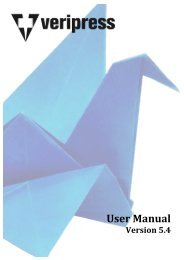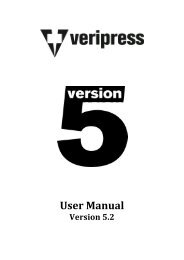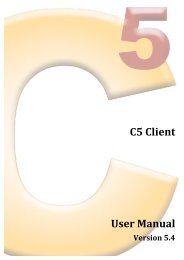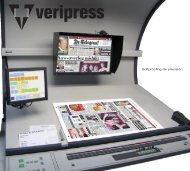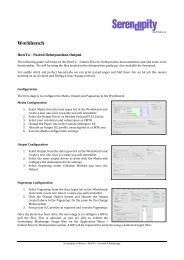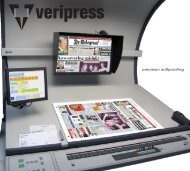Version 5.3.02 - Serendipity Software
Version 5.3.02 - Serendipity Software
Version 5.3.02 - Serendipity Software
You also want an ePaper? Increase the reach of your titles
YUMPU automatically turns print PDFs into web optimized ePapers that Google loves.
File Transfer Priority <br />
This specifies the priority to be used for transferring files from the RIP to Veripress. You can adjust from Lowest to <br />
Highest or anywhere in between. <br />
Sometimes a high priority can affect the RIP performance, especially on older RIPs. This can cause problems, such as <br />
RIPs pausing. If this happens, reduce the priority level. <br />
Paths <br />
Specify the paths to the RIPped files residing on your RIP. This may be a single path or multiple paths and can be made <br />
up of striped paths. The path structure is dependent upon the RIP driver selected. The options available are detailed <br />
below. <br />
• New – Adds a new path or stripe path to the Paths field. Selecting this displays another window to type the <br />
path or browse to locate the folder containing the jobs. Browse will only work if the connection method has <br />
been specified and is valid. <br />
• Delete – Deletes the selected paths. <br />
• Delete All – Deletes all paths from the list. <br />
Most RIP drivers use recursive polling, i.e., they will poll down the directory structure into sub directories from the top-level<br />
directory specified in the path. The more sub directories to be searched, the longer it takes. Specify the path as <br />
close as possible to your files for quicker results. <br />
Stripe Paths <br />
Some RIPs place jobs on different drives, but in the same location. They can add more drives to a RIP, giving it a new <br />
mount point, for e.g., E:/RIPJobs, F:/RIPJobs and G:/RIPJobs. These all have a common path of RIPJobs, but are “striped” <br />
across 3 drives, therefore specify the drives (E:, F: and G:) in the Stripe Paths and the path (/RIPJobs) in Paths. <br />
Note: This is important for RIPs sharing plates from single jobs across multiple drives, for e.g., Cyan & Magenta on E <br />
drive and Yellow & Black of the same job on F drive. If this is not setup as a stripe, the plates will not be stitched <br />
together. <br />
AutoProofing <br />
Jobs can be submitted manually from the RIPMonitor as desired. Alternatively, you can configure the RIP to have jobs <br />
submitted automatically via the AutoProof facility. This way any new job that appears, if stable and meets the specified <br />
criteria, will be submitted for processing. The options available are listed below. <br />
• Enable AutoProofing – Turns AutoProofing on or off. <br />
• Printing – Specifies how the jobs are to be printed. Options are: <br />
o Copies – Specify the number of copies to be printed. Default is 0. <br />
o Use Pagesetup – Print to the selected Pagesetup. <br />
o Choose – Select an existing Pagesetup or create a new one if necessary. <br />
Criteria <br />
You can select certain conditions that must exist before a job is automatically submitted. The options are: <br />
• Delay (seconds) – The length of time to wait to see if a job changes prior to submitting. A job may change as <br />
other plates are RIPped and added to the job. A suitable amount of time needs to be specified in order to <br />
ensure a complete job is submitted. <br />
• Minimum Plate Count – Specify a certain number of plates that must exist before a job is submitted for <br />
AutoProofing. <br />
• Must Have – Select which process plates must exist in the job before AutoProofing. <br />
• Filter – Select a filter to use for AutoProofing. See the Regular Expression section for further information on <br />
Filters. <br />
• Delete Jobs From RIP After AutoProofing – Delete jobs after a successful AutoProof. This is only available when <br />
jobs are locally hosted (Localhost polling). This may be used when a temporary file is created, for example, <br />
when adding halftone dots to unscreened data. <br />
• Hold After Imaging – Places the job on hold in the Rendering queue after imaging has successfully completed. <br />
• Hold After Rendering – Places the job in a held state in the Output queue after rendering has successfully <br />
completed. <br />
Job Filtering <br />
This is only available when the RIP driver is set to poll imposition RIPs. You can specify if AutoProofing should be <br />
carried out on All Jobs or just Imposed Jobs. <br />
<strong>Serendipity</strong> <strong>Software</strong> -‐ Veripress User Manual – <strong>Version</strong> <strong>5.3.02</strong> <br />
53



